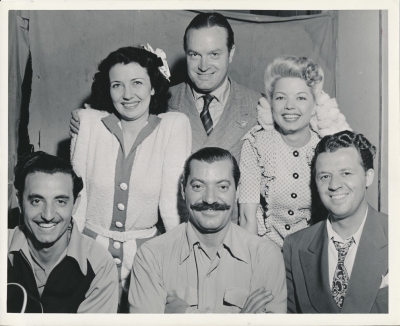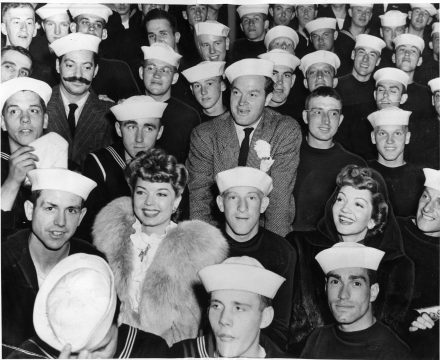Thanks for the Memory!
Bob Hope’s Long Forgotten Corona Recording to Play Dec. 23
By Naval Surface Warfare Center Corona Public Affairs

NORCO, Calif. – “Thank you very much. How do you do, ladies and gentlemen? This is Bob ‘Broadcasting from the Naval Hospital at Corona, California’ Hope.”
And with that, on Dec. 23, 1947, Bob Hope and Les Brown and his Band of Renown began to entertain hospital staff, guests from the community and Hope’s target audience, the patients – Sailors and Marines – many still recovering from World War II. Hope and his cast entertained with a half-hour of jokes, jibes and rapid-fire banter during his popular NBC radio show, broadcast from the auditorium in the Naval Hospital, the former luxury Norconian Resort Hotel where Hope vacationed years earlier.
And thanks to a decade-long search, the public will get to hear the entertaining show on the 70th anniversary of its first broadcast when the Navy will stream it live on Facebook, Saturday, Dec. 23, at 7 p.m. – its original broadcast time on the West Coast. It also features announcer Wendell Niles, Vera Vague, Jerry Colonna and singer Frances Langford.
Some priceless samplings include a classic Hope wisecrack: “It’s good to be here tonight. Of course, this is a little new to me. It’s the first time I’ve ever been in the hospital before a broadcast.” With his impeccable timing, Hope continued: “And this hospital is located in such rugged country, you have to get well before you can come here.”
Following a hilarious monologue, Hope and Langford perform a skit where they venture to nearby Ontario for some Christmas shopping. The show closes with a touching rendition of “Silent Night” and a sign off of Hope thanking Corona for hosting him and the many veterans at Corona and around the country who fought in World War II, giving us “stockings filled with freedom.”

The historic recording is part of Naval Surface Warfare Center Corona’s capstone celebration for the Navy’s 75th anniversary in the Inland Empire. When it goes live on Facebook, facebook.com/NAVSEACorona, it is likely the first time the show will have been broadcast since it originally aired on the NBC Radio Network in 1947.
Hope was familiar with California’s Inland region, making his first USO show May 6, 1941, at March Field in nearby Riverside, now March Air Reserve Base. March’s program was Hope’s first remote broadcast and paved the road for Corona’s performance years later.
Based on these appearances and prior visits to the Norconian, the warfare center’s public affairs director and historian, Troy Clarke, said he has been trying to obtain evidence for the past 10 years that Bob Hope came to the Navy base when it was a hospital.
“I always suspected it, but not until 2010 were we able to obtain a photo of Bob Hope from the USO that identified the location as Corona,” Clarke said.
Clarke and command archivist, Aida Cuevas, continued to dig. Cuevas found proof of the Corona show in the extensive Library of Congress collection of Hope’s body of work.
After more than a year, Clarke and Cuevas finally received NBC’s permission to obtain a digitized version of the original lacquer-disc recordings. Clarke said he’s been working for months to play the recording publicly on its 70th anniversary and the final permissions from NBC and the Bob Hope estate Dec. 20.
Cuevas discovered Hope performed three other shows around Southern California that December of ’47, including a Dec. 9 appearance at Occidental College in Los Angeles, and a Dec. 16 show at the Fox Theater in Pomona. On Dec. 30, Hope broadcast his show from Pasadena City College featuring the coaches of the Rose Bowl football teams.
Among these programs, Clarke says research of the Nielson Radio Index indicates Hope moved from a sixth-rated show in average audiences to second in popularity after the Corona broadcast – seemingly his highest rated show of December 1947.
On Christmas Eve, the Corona Daily Independent published its account of the show and reported the auditorium was packed to capacity, with Sailors and Marines confined to wheelchairs being placed in “favored” spots before the stage. The paper wrote that once the show completed the weekly broadcast at 7:30 p.m., Hope continued the show for nearly an hour, telling commanding medical officer Capt. J.W. Vann – whom he said he recalls seeing overseas – that he’d like to make another broadcast from the hospital soon. The paper reported that the versatile Hope also performed several soft-shoe and tap dance numbers.
At the conclusion of the Navy’s 75th year in the region, Dec. 15, Clarke played excerpts for the warfare center workforce in the command auditorium where Hope may have visited patients when he returned for later, non-broadcast show in 1952. The auditorium was the theater for the hospital’s tuberculosis ward that opened in 1943 and now houses workspace for the Navy’s current science and engineering mission on the property.
The discovery of the Hope broadcast adds to the Navy’s rich legacy in the Inland Empire. In the months and days preceding the Dec. 7 Japanese attack on Pearl Harbor, the Navy had been investigating buying the Norconian Resort to use as a hospital. Days before the attack, the Navy’s medical team conducted its final evaluation, and within hours of the attack, Capt. Frederick Conklin arrived at the hotel to advise its owner, Rex Clark, that the Navy was taking over the property. By direction from President Franklin D. Roosevelt, the Navy acquired the property and officially designated it Corona Naval Hospital Dec. 16, 1941 Conklin would later present Lt. John F. Kennedy with the Navy-Marine Corps medal for heroism during World War II.
Among Corona Naval Hospital’s first patients were Pearl Harbor survivors – one of whom, Donald Stratton, recently told his story aboard USS Arizona in the New York Times-bestselling book, All the Gallant Men. Another was James Leavelle – who later became the Dallas homicide detective who interrogated President Kennedy’s assassin, Lee Harvey Oswald, to whom he was later handcuffed when Jack Ruby shot Oswald.
Corona Naval Hospital housed an extensive medical staff throughout the war, providing medical treatment for some 5,000 patients at its peak. As treatment concluded following World War II, it closed in 1951, reopened to support the Korean War, and finally closed in 1957.
The science and engineering mission that began for guided missiles in 1951 continues today at its original site and, along with new state-of-the-art facilities, has developed into the Navy’s premiere independent assessment and analysis agent that help warfighter’s train, fight and win. Headquartered in Norco, the warfare center has some 3,200 military, civilian and support contractors around the country.
Tags: Bob Hope

